Saint Peter’s Basilica
Saint Peter’s Basilica, located in the Vatican City, is considered one of the Catholic Church’s holiest sites and foremost pilgrimage destinations, which marks the burial site of Saint Peter, Christ’s foremost apostle and the first ever pope. This is where Peter’s successor, the present pope, presides over religious rituals and celebrations.
Location:
Piazza San Pietro
Built by:
Bramante, Michelangelo, Carlo Maderno, Gian Lorenzo Bernini between the 1506 and the 1626 d.C.
What to see:
Basilica, Bernini's canopy, dome, Michelangelo's Pietà
Opening hours:
Everyday, 7.00-18.30
Price:
Free entrance to the basilica
Transport:
Metro station: Ottaviano at 960 m.
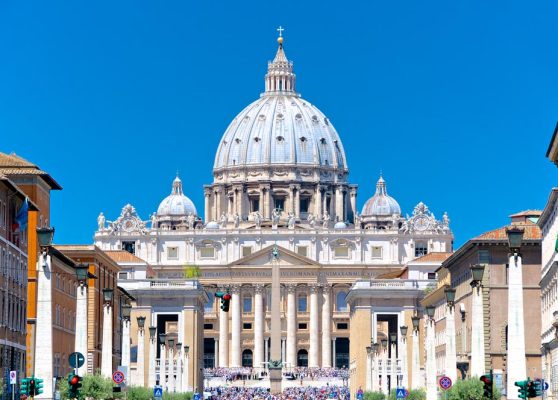
Top selling tickets on ArcheoRoma
The papal major archbasilica of St. Peter’s in the Vatican is the symbol of the Catholic church in the world and is the largest of the four papal basilicas in Rome . Located in the small papal state of the Vatican in St. Peter’s Square, it is the seat of the main manifestations of Catholic worship.
The majestic monument is now a UNESCO World Heritage Site and is one of the most visited tourist destinations in Rome, both for pilgrimage reasons and due to the architectural and artistic excellence of the building and the works it houses.
In fact, visiting St. Peter’s Basilica we can admire the extraordinary façade created by Carlo Maderno, the refined interiors of the church, the 46 altars, the 11 chapels which house works such as Michelangelo’s Pietà and Bernini’s canopy. We can also visit the tomb of San Pietro and reach the dome created by Michelangelo, from which you can enjoy one of the most memorable views of Rome.
In this place, on the Vatican Hill and on the other side of the Tiber River, in 318 AD the Emperor Constantine decided to build a large Basilica in honor of the Apostle St. Peter, known as the Constantinian Basilica . Construction began between 319 and 322, consecrated in 326 AD and finally completed around 349 AD. The old Basilica of Constantine remained standing until the time of Pope Paul V , when it was finally demolished.
After a period of abandonment that lasted 1200 years, it was only in 1506 that Pope Julius II entrusted the project for the new and current St. Peter’s Basilica to Donato Bramante . The boundless ambition of Pope Julius II for himself and for the papacy, gave rise to the construction of the most grandiose and famous church in the world, where great artists such as Michelangelo, Antonio da Sangallo, Carlo Maderno and Gian Lorenzo Bernini worked.
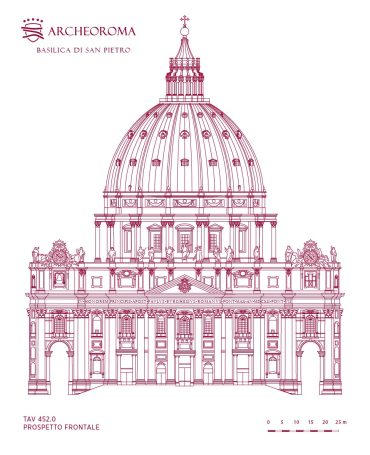
Bramante proposed a huge structure with a central plan in the shape of a Greek cross enclosed within a square with an immense dome above the centre. In 1506 the first stone of the new basilica was laid; the work lasted for over a century.
Bramante was succeeded as chief architect by Raphael , and when Raphael died, Michelangelo took his place and designed the dome we see today. Both Michelangelo and Raphael made concrete changes to the original project.
At the time of Michelangelo’s death in 1564 only the drum of the dome had been built which was completed in 1590 by Giacomo della Porta. At the request of Pope Paul V, the imposing building was further expanded by Carlo Maderno in a project with an authentic Latin cross plan, which he then enriched with the facade in 1614.
The church was finally reconsecrated in 1626 by Pope Urban VIII , exactly 1300 years after the first church was consecrated. Since then, St. Peter’s Basilica has been the center of Christianity, the spiritual destination of pilgrims and tourists from all over the world who visit the church every year.
The building itself is of remarkable proportions. The nave is 211.5 meters long (including the narthex) and the dome measures 42 meters in diameter reaching 132.5 in height. Once inside the basilica, one is literally breathless admiring its magnificence and the absolute masterpieces kept in it.
The building is of considerable size. It has a nave 211.5 meters long (including the narthex) and reaches 132.5 meters in height thanks to the dome, for a total area of approximately 23,000 square metres.
It has a total of 45 altars and 11 chapels, where a large number of works of inestimable historical and artistic value are housed.
| Length | 114,69 m |
| Height | 54,44 m |
Work began in 1607 and was completed by architect Carlo Maderno in 1614. By altering Michelangelo’s original design, Carlo Maderno’s design places the gigantic columns against the facade rather than in front of the building.
It is 115 meters wide by 54 in height; an order of Corinthian columns and pillars support a grandiose cornice with a central tympanum, surrounded by a majestic balustrade with thirteen statues. An inscription on the entablature recalls the circumstance of the construction during the pontificate of Pope Paul V Borghese (1605-1621):
“IN HONOR OF THE PRINCIPLES APOST PAVLVS V BVRGHESIVS ROMANVS PONT MAX AN MDCXII PONT VII”
(transl. In honor of the prince of the apostles; Paul V Borghese Pontifex Massimo Romano year 1612 seventh year of the pontificate)
Located above the central entrance is the so-called “Loggia delle Benedizioni” window , where the Supreme Pontiff imparts his first “Urbi et Orbi” blessing (to the city and to the world) on Christmas, Easter and his election.
Carlo Maderno (1556 – 1629), lived his childhood in Capolago, Switzerland. Already demonstrating great skills in architecture as a young man, he was entrusted to Carlo Fontana, architect. This allowed the boy to try his hand at important construction sites that gave him fame and Roman citizenship (eg the facade of the church of Santa Susanna). In 1603 he won the tender to carry on the Michelangelo complex and the facade of San Pietro. He completed the dome of St. Peter’s from drawings by Michelangelo.
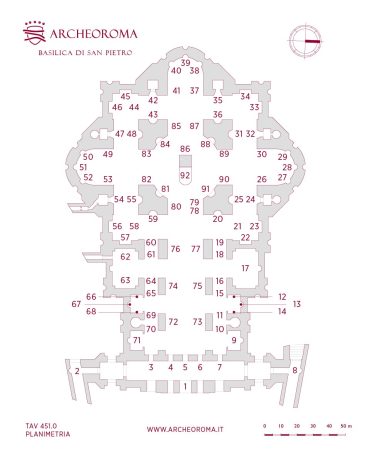
The portico extends for all 115 meters of the span of the facade. It is accessed from the central gate located on the facade and allows access to the basilica through 5 doors.
There are five doors that allow access to the basilica:
Among the thousands of holy doors around the world (it is not known the exact number), that of San Pietro is the most important, but not the first. The Holy Door of St. Peter’s Basilica dates back to 1500, while the threshold in San Giovanni in Laterano dates back to 1423.
Reading the Old Testament (Ezekiel 46, 1-3), the Holy Door is the “place through which man passes to meet God”.
The opening of the Holy Door is a fundamental rite of the Jubilee , representing the offering of an “extraordinary path” to salvation.
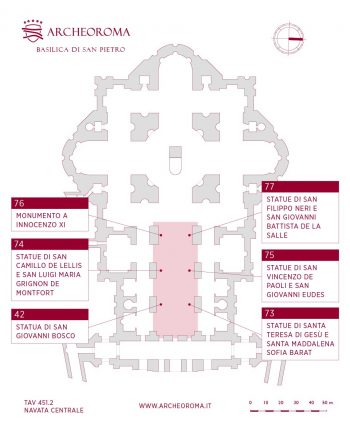 Immediately inside the central door is a large round porphyry slab in the floor. Here Charlemagne and other Roman emperors knelt for
Immediately inside the central door is a large round porphyry slab in the floor. Here Charlemagne and other Roman emperors knelt for
their coronation.
Extraordinarily refined is the design of the marble floor, the work of Gian Lorenzo Bernini for the jubilee of 1650, together with the decorations of the nave. The interiors of the pillars that separate the central nave from the side ones have niches filled with statues of the founding saints ; the nave culminates in a rich barrel vault ending behind the colossal Baldacchino with twisted columns by Bernini in the monumental Chair of St. Peter .
In the central nave we find:
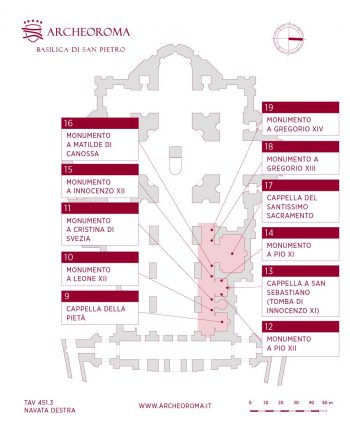 In the right aisle we find, starting from the bottom:
In the right aisle we find, starting from the bottom:
In the first chapel inside the Basilica, on the right, we find the extraordinary Pietà by Michelangelo, the first masterpiece created by the Renaissance master when he was just twenty-two. It is considered one of the absolute masterpieces among the works of art that the West has ever conceived.
The marble group was commissioned by the French cardinal Jean de Bilhères de La Groslaye , Charles VIII’s ambassador to Pope Alexander VI, and was intended for his own burial in the church of Santa Petronilla. As soon as the work was completed, thanks to the great admiration and rapid success, it was decided to locate it in St. Peter’s.
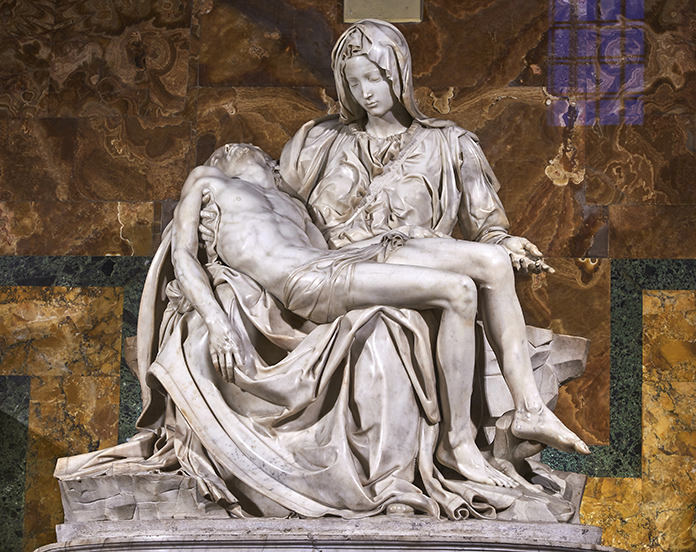
One of the curiosities of this work is that it is the only one to be signed by the brilliant Master; on the shoulder band that holds the Virgin’s mantle we can find the writing: MICHEL.A[N]GELVS BONAROTVS FLORENT[INVS] FACIEBAT (Michelangelo Buonarroti, Florentine, did it). Made of Carrara marble, it was the first of a long series of works sculpted with this excellent material by the sculptor Michelangelo Buonarroti.
The two figures of Jesus and the Virgin Mary create a pyramidal composition in their dynamic pose, joined by a large drapery worn by the Virgin herself, which rests on a rocky relief. The youth of the female figure aroused several criticisms, refuted by the artist himself who wanted to symbolically represent the young woman in the work when she conceived Christ.
In 1972 it suffered an act of vandalism, which caused significant damage, in particular to the Virgin Mary. A delicate restoration was then carried out.
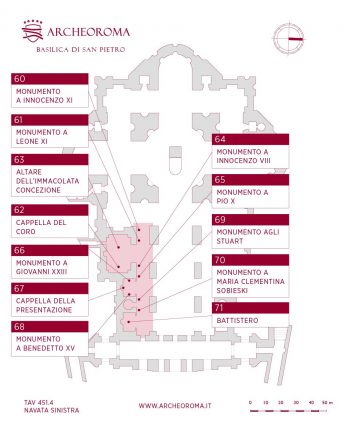
In the left aisle we find, starting from the bottom:
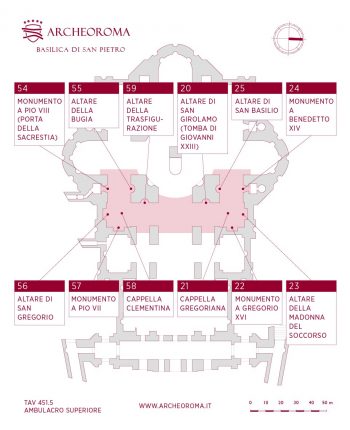 In the lower ambulatory (or surgery) we find:
In the lower ambulatory (or surgery) we find:
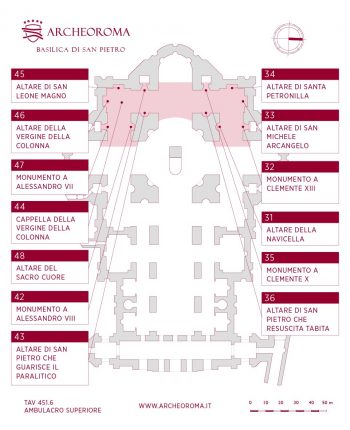 In the upper ambulatory (or ambulatory) we find:
In the upper ambulatory (or ambulatory) we find:
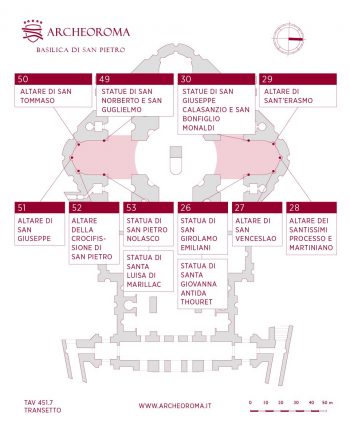 While in the project of the Constantinian period the transept was in the shape of a commissa cross (i.e. with the transept placed at the top of the naves), in the current project created by Michelangelo Buonarroti it is in the shape of an immissa cross , perpendicularly intersecting the longitudinal arm of the basilica.
While in the project of the Constantinian period the transept was in the shape of a commissa cross (i.e. with the transept placed at the top of the naves), in the current project created by Michelangelo Buonarroti it is in the shape of an immissa cross , perpendicularly intersecting the longitudinal arm of the basilica.
It is divided into the northern transept, which is the arm that extends towards the Vatican palaces, and the southern transept, which extends towards the sacristy.
In the southern transept we find (clockwise):
In the northern transept we find (clockwise):
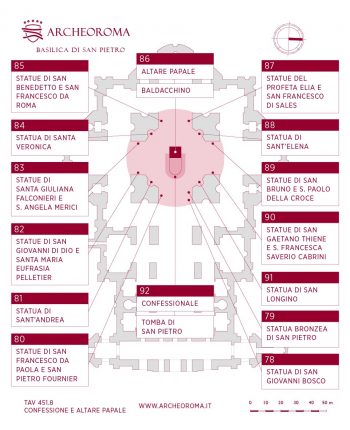 Under the dome there is the confession, generally used to welcome and preserve the relics. The confession of St. Peter’s basilica welcomes the Tomb of St. Peter .
Under the dome there is the confession, generally used to welcome and preserve the relics. The confession of St. Peter’s basilica welcomes the Tomb of St. Peter .
Thanks to the mirrored flights of stairs which are accessed via a small wooden door, one descends into a semicircular recess defined by brocatelle balustrades alternating with pillars decorated in oriental alabaster and black and white marble. The polychromy adopted in the marble of the walls and floors embellishes the work, which is one of the most interesting for its meticulous use of semi-precious stones of the seventeenth century.
Thanks to a series of archaeological explorations undertaken in the first years of papacy by Pope Pius XII Pacelli (1939-1958) in the area of the confessional, it was possible to bring to light a Roman necropolis dating back to the 3rd century which occupied an area beside the Circus of Nero (where the ferocious persecutions against Christians were carried out during his regency).
To be precise, on the southern slopes of the Vatican hill, where a small funerary aedicule called the ” Trophy of Gaius ” and a tomb surrounded by a wall of respect (the “red wall”) covered with Christian graffiti were found . An inscription in Greek with the name of Peter (“petr[os] enì”, Peter is here) convinced the archaeologist Margherita Guarducci and the Vatican to identify with certainty that this was the tomb of St. Peter.
Taking these conclusions as historically true, the bones of St. Peter are today in a plexiglass case in the confessional, placed on the perfect vertical projection of the center of the dome.
In the area surrounding the Confession, exactly between the 41.55 meters in diameter of the dome, there are a number of notable works to visit:
The papal altar of St. Peter’s basilica is one of the eight main altars present in the papal basilicas and in the papal basilicas of Loreto and Padua.
Basilicas that welcome a papal altar:
The papal altar of St. Peter’s basilica stands above the confessional and in the center of the more famous St. Peter’s Baldacchino , designed by Gian Lorenzo Bernini.
It was originally the altar of Gregory the Great (590-604), then replaced by the altar of Callistus II (1123) and finally replaced by the current altar of Clement VIII of 1594. In white marble with gray veins, the papal altar it has a front with four columns that frame three panels without particular decorations.
Built between 1624 and 1633, the Baldacchino di San Pietro is a monumental work designed by Gian Lorenzo Bernini . It was entrusted to the Neapolitan sculptor, architect, painter and urban planner by Pope Urban VIII, even before entrusting him with the direction of the works of the basilica, which took place following the death of Carlo Maderno at the beginning of 1629.
The majestic project consists of a bronze structure placed to protect and indicate the tomb of St. Peter. Developed on four twisted columns characterized by naturalistic motifs, it ends with four volutes supported by angels who bend on the back of a dolphin and culminates with the globe and the cross.
The work is supported on four twisted columns 11 meters high, whose three sections were melted separately:
The columns draw inspiration from the Temple of Solomon (the first Jewish temple in Jerusalem, dated 960 BC) and create continuity with the spiral columns of the pergula (old St. Peter’s basilica, confessional). I give the work an upward momentum in the direction of Michelangelo’s dome.
They are adorned with bronze naturalistic elements such as laurel and laurel branches (in reference to the well-known Latin poetic talent of Urban VIII), bees (symbol of the Barberini family, to which Pope Urban VIII belonged) and lizards (symbol of rebirth and the search for God ).
A concave entablature, typical of the Baroque joins the four pillars of the canopy. Four dolphin-backed volutes branch off from here, supporting a golden globe surmounted by a cross. The result is a particularly light and dynamic look.
On the four corners there are statues of angels, while putti are placed above the drapes that cover the entablature. These works are signed by one of the greatest exponents of Baroque architecture: Francesco Borromini.
We often read that the bronze used for the columns of the canopy of St. Peter’s is the same removed and cast from the beams of the pronaos of the Pantheon. The result was even a ” pasquinade ” (the act of hanging sheets of biting satire dedicated to the most important public figures from a 3rd century statue found in 1501), which read as follows:
” What the barbarians didn’t do, the Barberini did “.
It was later discovered that 90% of the bronzes of the Pantheon were actually used to make 80 cannons for the Mausoleum of Hadrian, that perhaps a minimal part of the bronze of the Pantheon was used for the canopy (the origin of the bronze is Venetian) and that the author of the pasquinade was Monsignor Carlo Castelli, ambassador of the Duke of Mantua.
| Total weight | Approximately 14,000 tons |
| External height (including cross) | 133.30 meters |
| Internal height (floor to lantern vault) | 117.57 meters |
| Lantern height | 18 meters |
| Outer diameter | 49 meters |
| Internal diameter | 41.55 meters |
Designed by Michelangelo, he worked on the work until his death when the construction had been erected up to the drum. His pupil Giacomo Della Porta took charge of the direction of the works, raising the vault of the dome by 7 meters to complete it in 1590. The overlying lantern is 17 meters high.
This architectural masterpiece served as a model for other domes in the western world. These include those of Saint Paul in London (1675), Les Invalides in Paris (1680-1691) and the Capitol in Washington (1794-1817).
The height of St. Peter’s dome from the ground, if we also consider the cross, is 133.30 meters. To get to the ascent of the dome we will have to climb 537 steps.
Saint Peter’s Basilica: your opinions and comments
Have you visited this monument? What does it mean to you? What advice would you give to a tourist?
Saint Peter’s Basilica tickets